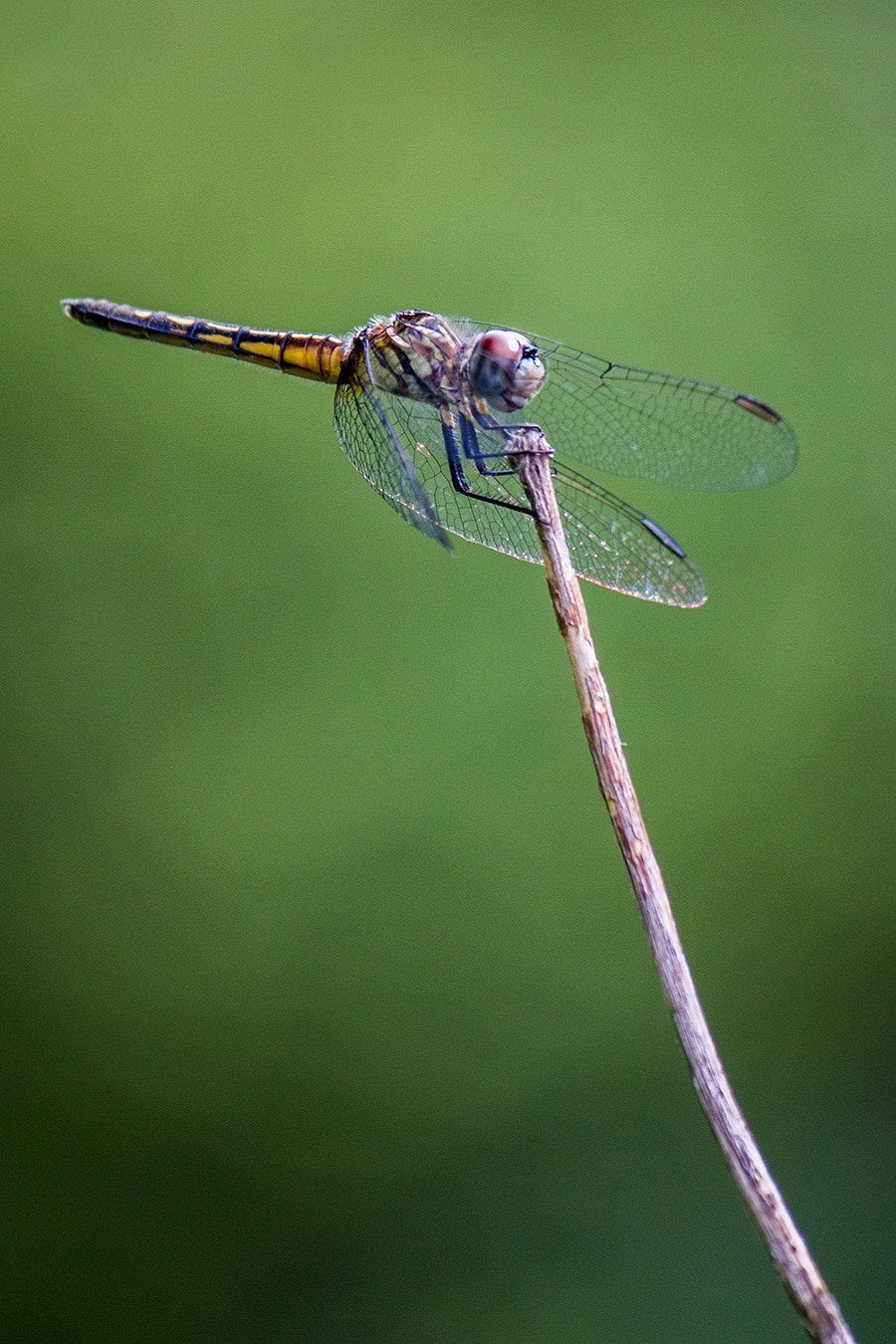
It has been an interesting season for insects, with visits from species I’ve never seen in this garden. I expect the changing climate patterns have created favourable conditions for some of these new visitors. I’ve enjoyed a mated pair of ebony jewelwings (Calopteryx maculata), broad-winged damselflies that resemble dragonflies. The male grows two inches (5 cm) long and makes a dramatic appearance with velvety black wings and an iridescent blue-green body. The slightly smaller female is dark brown and has a white spot on each wing tip.
They fly together, sometimes chasing and teasing, while at other times share a leaf for a quiet rest. Jewelwings are tasty morsels for their primary predators — robins, blue jays and red-winged blackbirds — of which there are many in the garden. The pair of jewelwings I’ve been watching seem fast enough to keep ahead of the birds, although they’re tempting fate by flitting around the busy birdbath. They’re inclined to land on large, flat leaves, such as those on the ‘Sum and Substance’ hosta that grows below the birdbath.

In the same birdbath territory, I’ve also had a striped meadowhawk dragonfly (Sympetrum pallipes) buzzing about and flaunting his superior size and buggy eyes. This fellow, also known as a skimmer or darter, is mostly seen in late summer and autumn, foraging in meadows and along streams. My meadowhawk’s gold-bronze colouring indicates he’s a juvenile in his first year of flight. With maturity (and if the robins allow) he’ll become bright red on part or all of his body. He has large, transparent wings that fold forward when he perches on a stick or the end of a twig. Unlike the jewelwings, the meadowhawk avoids horizontal leaf surfaces and always favours a vertical perch.
It just so happens that aphids are a delectable treat for damselflies and meadowhawks, and what serendipity that a large colony of bright red aphids (another first-time visitor) has begun to gorge on the tender stems of a rudbeckia clump directly across from the birdbath. It seems this is a win-win situation for all parties, so long as everyone keeps moving swiftly. (Unfortunately, the red aphids don’t have enough wits to keep out of the chow line.)
I’ve been trying to attract pollinators in the front garden, curious to see what might show up in a city garden that’s far away from agricultural fields and orchards. With so much concern about the decline in the number of pollinators, I’m pleased to find that there are still lots of these industrious garden partners buzzing about. Their diversity is impressive, with several dozen kinds of bees, wasps and small flies industriously working the plants from dawn to twilight every day. I planted various kinds of salvia and penstemon , and these were certainly a big draw. My small colony of biennial rusty foxgloves (Digitalis ferruginea, Zone 5) is enormously popular, particularly with honeybees.
There have been other surprises, too. Three coneflower cultivars are poor draws for the buzzers, perhaps because their hybrid breeding history has caused a decline in nectar production. (I’ll try a species echinacea next year.) But an unexpected success has been the enthusiastic activity around Pinky Winky panicle hydrangea (Hydrangea paniculata ‘DVPpinky’, Zone 4), Fire and Ice (H. p. ‘Wim’s Red’, Zone 4) and ‘Kyushu’ (H. p. ‘Kyushu’, Zone 4). The flowers on Pinky Winky and Fire and Ice turn red as the blossoms age, while ‘Kyushu’ remains creamy white. These floriferous shrubs attract a happy crowd. My ‘Annabelle’ hydrangea (H. arborescens ‘Annabelle’, Zone 4) has absolutely no appeal to pollinators and I’ll replace it next year with another of the panicle species. There’s so much fun to be had watching these pollinators, that I don’t want to waste garden space on a plant pollinators ignore. The individual florets making up ‘Annabelle’ blooms are all flat, sterile blossoms and don’t produce nectar. The panicle hydrangea blossom clusters are made up of both sterile flowers (flat open petals) and fertile flowers (small bud-like shapes), and seem to be lavish with their nectar.
Sad to say, the three butterfly bushes (Buddleia davidii, Zone 6) have few customers, only a few cabbage whites (Pieris rapae) landing for a quick taste. Last year the garden was full of red admiral butterflies (Vanessa atalanta), but I haven’t seen one this summer. Also, I haven’t seen one of my favourite buzzers, the sweet little leaf-cutter bee (Megachile species). There has been a gorgeous tiger swallowtail butterfly (Papilio glaucus) flitting about, first seen in April and still with us. So far, no orange monarchs, but there’s still time. I’m on the watch.

I en joyed your article, which I found in a search on whether dragonflies (we called “darning needles” in my childhood), could ever be “accidental” pollinators–as they would fly from plant to plant, over the pond or lake (there are many at Broadmoor Wildlife Sanctuary in Natick, MA), between catching mosquitos and other insects on the fly, resting on broad-leafed flowering lily pads and other plants. Could they pick up pollen on their wings and long bodies and inadvertently move it from plant to plant while seeking their bug meals? I wonder if you have any ideas on this. Many thanks, and many thanks again for your fine article 😉 Carol
I have recently had precisely the same question as this. I often refer to Odonata (Damselflies and Dragonflies) as ‘accidental pollinators’. Personally, I can’t see any reason why they couldn’t inadvertently pick up pollen on the hairy legs/feet and unknowingly transport it to another flower of the same type – say in a Lavender field, for example. Perhaps a pollinator though, is defined by how much pollen in transports, rather than if it does or doesn’t transport it at all. I’d surely love to have the answer to this once and for all. Any advice hugely appreciated. Thanks in advance.